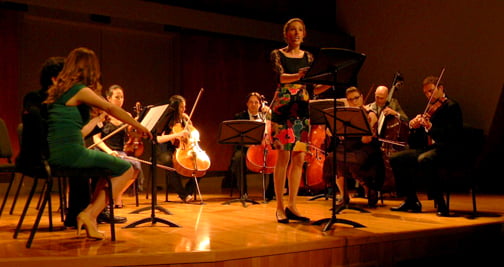Estranged from the majority of the traditional listening audience that found itself unable or unwilling to comprehend their pioneering work in charting new possibilities of musical expression – often questioning the very notions of silence, sound, and music itself – the path that many of the 20th century’s avant-garde composers walked could sometimes be a very lonely one. (See Giacinto Scelsi.) That solitude bred among a number of these composers a need to find support from those who shared their ideals – solidarity with their own kind. There’s the “Second Viennese School,” the post-war “Darmstadt School” which shaped the course of a kind of highly organized, maximalist musical modernism that surged in the 1950s and 1960s. A little later and a little different were the New York based “minimalists”: shunned and mocked at first, now perhaps part of the dominant strain in contemporary American music.
The reaction against this modernism was widespread. It was also more diffuse – an important detail. Unlike their avant-garde rivals, there was no real structured, systematic opposition; certainly it lacked a bit of charisma. There was, instead, a faint recognition of kinship. In many ways Benjamin Britten, if not a leader in this movement (there would have been no movement to lead anyway), was, as the Salastina Society demonstrated in its program on Sunday, a nexus for the partisans of tonality.
A significant part of that alternate 20th century – a 20th century musical ethos that was grounded in the belief that classical forms were not only viable but were destined to endure – crossed the path of the English composer.
Dmitri Shostakovich, who was represented in his early “Two Pieces for String Octet, Op. 11” late in life, became an intense admirer of Britten’s work. He dedicated his “Symphony No. 14, Op. 135” to Britten (the Englishman would reciprocate by dedicating his “The Prodigal Son” to the Russian) and invited Britten and his life partner Peter Pears to stay at his family dacha while the pair visited the Soviet Union. Like Britten, Shostakovich sought to reconcile traditional forms with contemporary expression. Unlike Britten, however, Shostakovich in his youth was briefly under the spell of the Western modernism espoused by the likes of Paul Hindemith, Arnold Schoenberg, Alban Berg and especially Ernst Krenek.
With each of its two movements respectively falling immediately before and after his epochal “Symphony No. 1, Op. 10,” the “Two Pieces” is a Janus-faced work. The opening “Prelude” represents some of the last gasps of Shostakovich’s juvenile style, its roots in Tchaikovsky, Rimsky-Korsakoff, and – surprising given his later intense disdain for the composer – Scriabin, though its impassioned solo violin is already distinctively Shostakovichian. (Incidentally, the recurring drooping intervals heard in the cello reappeared virtually intact nearly 50 years later in the composer’s final string quartet.)
On the other hand, the frantic fugato of the “Scherzo” bristles with the kind of newly won freedom the composer must have felt upon completion of his conservatory studies. It’s harsh music, intensely dissonant, forged in steel.
The civilized composure of the two works by Aaron Copland and Frank Bridge that followed were each in different ways and despite themselves reflections of disillusionment in the modernist dream. For Copland, in his late 1920s “Two Pieces for String Quartet,” it was the pursuit of an ideal that ultimately proved to be a dead-end for the composer. In Bridge’s charming and witty “Cherry Ripe,” it was the unspoken pallor cast by the mechanized horror of World War I that was underway during the piece’s composition that gave it a sense of poignancy likely unimagined at the time by the composer, whose work post-war would turn darker, more austere, even misanthropic.
The program’s center of gravity was Britten’s setting of Arthur Rimbaud’s “Les Illuminations,” a work that at once expresses clear-eyed disenchantment with the world as well as a young man’s arrogance that he is at the center of it.
Concluding its third season, the Salastina Society’s concert at the Colburn School of Music’s Thayer Hall was yet another harvest from the bumper crop of world-class chamber music that Southern California has been enjoying in recent years. Its program wasn’t merely a potpourri or an omnibus of various odds and ends that were made to fit together. Genuine care and thought was clearly put into assembling these works into a context that illuminated facets of them that are often overlooked, how across continents and decades they were woven from the same thread that formed the zeitgeist from which they originated.
No less care was lavished on the performances themselves; each of the musicians on stage formidable solo artists in their own right. Their unanimity of tone, elegant phrasing, deep expressiveness, and bristling energy had to be heard to be believed. The virtuosity of the ensemble as heard in the texturally complex works by Shostakovich and Britten was fearless, elucidating each strand in the musical argument with enviable aplomb. Adrienne Pardee, the soprano soloist in the Britten, was fully up to the demands of the score, deftly navigating its heady brew of swagger, acidulous irony, and urban solitude with her own remarkable sense of control and word-painting.
The name of the Salastina Society may not be known even to some of the region’s hard-core chamber music buffs. It’s one of Southern California’s best-kept musical secrets – but extraordinary performances such as Sunday’s will assure it a lasting fame well beyond the Golden State’s borders.

